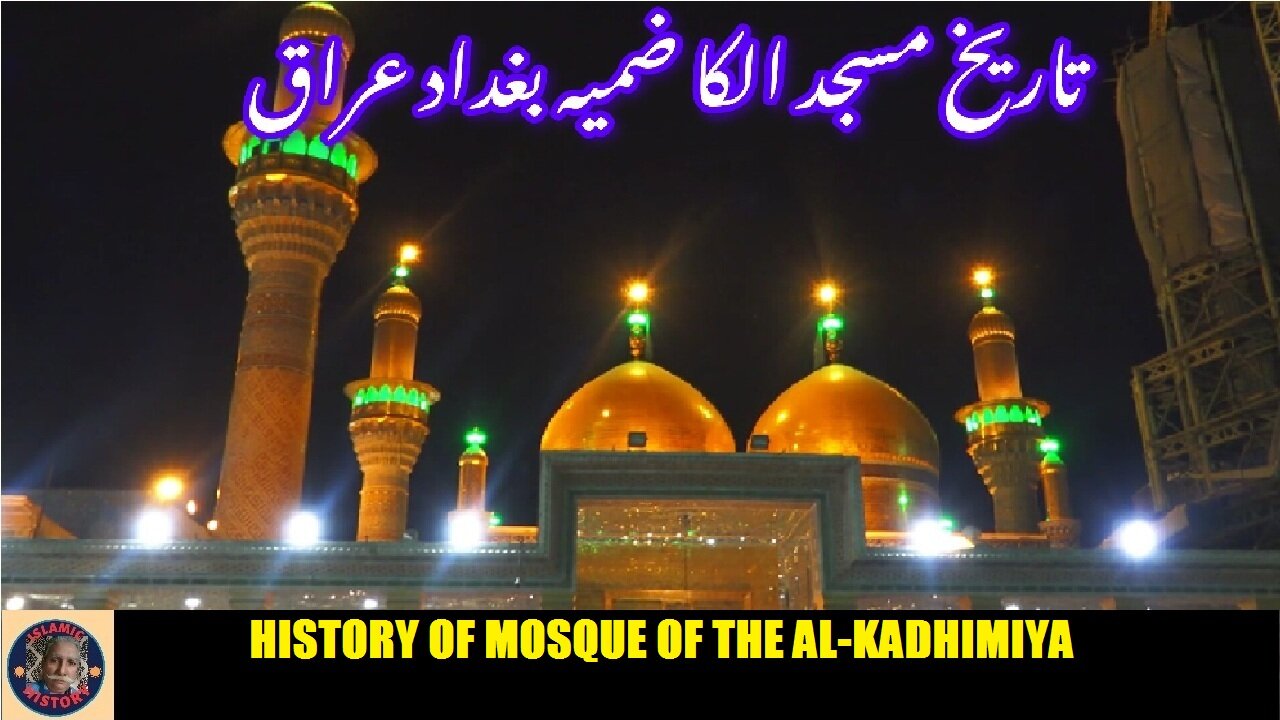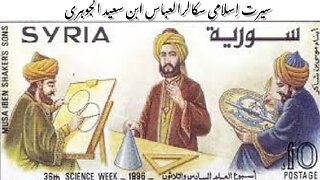Premium Only Content

P-1 | History of the Al-Kadhimiya Mosque | الکاظمیہ مسجد کی تاریخ
@islamichistory813 #Kadhimiya #IraqHeritage #CulturalLandmarks
History of the Al-Kadhimiya Mosque in Baghdad Iraq
Part-1
Dekhti Aankhooon aur sountay kaanoon ko Asslamoalaikum, sisters, brothers friends and elders, In this holiest places informative video, we are describing the Al-Kadhimiya Mosque, a landmark of spiritual and historical significance in Baghdad Iraq. The narrative covers its origins, architectural style, and the various historical events that have occurred within its walls. We are describing how this mosque has become a symbol of faith and resilience for the local and international islamic community. its history we descring in two parts and this is its first part.
Al-Kadhimiyya Mosque is a Shi'a Islamic mosque and shrine located in the Kadhimiya suburb of Baghdad, Iraq. It contains the tombs of the seventh and ninth Twelver Shia Imams, respectively Musa al-Kadhim and his grandson Muhammad al-Jawad. Also buried within the premises of this mosque are the historical scholars Shaykh Mufid and Shaykh Nasir ad-Din at-tusi. Directly adjacent to the mosque are two smaller shrines, belonging to the brothers Sayyid Raad (who compiled Nahjul-Balaghah) and Sayyid Murtad? and Qadi Abu Yusuf al-Ansari.
The mosque was built on the site of a Quraysh cemetery, which was created with the original Round City of Baghdad in 762. The cemetery in an old Arab town named "Shoneezi" (Meaning the Black Grain) was founded by Abbasid Caliph al-Mansur so that members of his family and internment can be buried in it. It is generally believed that Zubaidah bint Ja'far and al-Mansur himself were also buried in this location. The town, along with its tombs, would become al-Kadhimiya, an area and suburb located north of central Baghdad. This cemetery became the burial site of the seventh Twelver imam Musa al-Kadhim in 799, followed by his grandson, the ninth imam Muhammad al-Jawad, in 834. The current building dates to the restoration carried out by the Safavid Iranian Shah Ismail I from 1502 to 1524. It was further ornamented by the Ottoman Sultan Suleiman the Magnificent after he conquered Baghdad in 1534. Since then, it has continued to be kept in a state of good repair. Similar to many other Islamic settlements throughout history, settlements throughout time started to develop around the mosque which came to be known as al-Kadhimiya area.
In 1611, the Ottoman Sultan and Caliph Ahmed I granted Jamal al-Din bin Mullah Ali, a descendant from Bani Shaiba, a firman, a royal decree, allowing him and his family to have full custodianship of the mosque and its shrine. Ancestors of Jamal became known as the al-Jamali family who were entrusted with the mosque and kept the firman. Among the most notable members of the al-Jamali family was Sheikh Abbas al-Jamali, who lived next to the mosque with visitors meeting him and was the father of Iraqi Statesman Muhammad Fadhel al-Jamali, who would become one of the founders of the United Nations in 1945.
During the 1920 Iraq Revolt against the British Empire, al-Kadhimya Mosque was among the many sites around Baghdad to see national gatherings aimed to revolt against the British. These gatherings were noted by Musa al-Shabandar who saw similar gatherings such as in the Haydar-Khana Mosque. These gatherings also coincided with Mawlid and Husayni condolences and saw significant Islamic unification as noted by al-Shabandar.
During and after the Iraq War, the mosque was among the many sites across Iraq to be targeted by terrorist attacks. On 2 March 2004, at least 75 people were killed and hundreds of others were wounded as crowds had gathered to commemorate ‘?sh?r?'. The event caused outrage and led to angry crowds injuring two American soldiers by stoning them. Iraq's Governing Council blamed the attack on terrorists enflaming sectarian tensions. Concurrent explosions also occurred at the Im?m Husayn Mosque in Karbal?. This mosque was the destination of the crowd that was caught up in the Baghdad bridge stampede.
On 6 June 2007, at least seven people were killed after twin car bombings occurred near the mosque, one at al-Zahra'a Square, and the second 300 meters away at the Aden intersection. The event coincided with police officers discovering the 47 victims of torture conducted by Shi'i Sectarianist militants. Almost exactly a year later on the evening of 27 June 2007, a car bomb killed at least 14 people and injured 22 others. Officials say that the victims were mostly locals "enjoying a warm summer evening."
On 28 March 2004, a freshly gilded dome over the grave of Muhammad at-Taqi was unveiled to the public, as crowds had gathered in celebration of Mawlid (the birthday of Muhammad) as well as the birthday anniversary of his descendant, Ja‘far as-Sadiq.
On 28 December 2008, a car bomb exploded on a busy road leading to the mosque killing at least 24 people and wounding 46 others, many of them visitors to the mosque. The explosion occurred about 100 yards from Bab al-Dirwaza, one of the main gates to the shrine.
On 7 January 2009, A male suicide bomber dressed as a woman, killed 38 and injured 72 visitors as they were preparing for the day of Ashura. The attack was considered one of its worst in months by the Los Angeles Times. Later on 8 April, 2009, 7 people were killed and 23 others were wounded after a bomb that was left in a plastic bag near the mosque detonated. Iraqi officials have warned that they expect a rise in attacks.Then on 24 April 2009, violence hit its highest since the 2003 invasion, and among the attacks included Two female suicide bombers killed at least 66 people and wounded 125 others as people were heading towards the mosque for Friday prayers. The attacks was suspected to be backed by al-Qaeda in Iraq. Residents in the area called the event a "massacre" noting the bodies, some burnt, scattered on the ground. The event caused many Iraqi security men to be suspended due to their lack of providing adequate security around the shrine.
so sisters brothers and friends, inshaAllah tomorow we will be described History of the Al-Kadhimiya Mosque in Baghdad Iraq. Allah Hafiz
=======================================
-
 7:53
7:53
ISLAMIC HISTORY
1 day agoBiography of Al-Abbas ibn Said al-Jawhari سیرت العباس بن سعید الجوہری
8 -
 LIVE
LIVE
Alex Zedra
1 hour agoLIVE! Playing BO7 Beta!
305 watching -
 1:52:56
1:52:56
TimcastIRL
2 hours agoElon Musk Says Woke NGO Responsible For Charlie Kirk Assassination | Timcast IRL
96.6K58 -
 1:26:12
1:26:12
Steven Crowder
13 hours agoThe Left is Violent (Part 2) | Change My Mind
491K793 -
 LIVE
LIVE
Man in America
6 hours agoDollar Collapse is Engineered to Herd Us Into CBDC Prison—David Jensen EXPOSES the Playbook
674 watching -
 5:16:01
5:16:01
MattMorseTV
5 hours ago $6.15 earned🔴CHILLING + TALKING🔴
71.1K3 -
 2:04:23
2:04:23
The Charlie Kirk Show
3 hours agoTHOUGHTCRIME Ep. 99 — THOUGHTCRIME IRL
79.2K28 -
 DVR
DVR
Flyover Conservatives
10 hours agoSilver Shortage ALERT: London Vaults Running Dry in 4 Months- Dr. Kirk Elliott; 3 Tips to Transform Your Business - Clay Clark | FOC Show
12.9K2 -
 1:10:18
1:10:18
Glenn Greenwald
5 hours agoIsrael Pays Influencers $7,000 Per Post in Desperate Propaganda Push: With Journalist Nick Cleveland-Stout; How to "Drink Your Way Sober" With Author Katie Herzog | SYSTEM UPDATE #525
87.2K92 -
 38:54
38:54
Donald Trump Jr.
8 hours agoDems' Meme Meltdown, Plus why California Fire Victims should be more Outraged than Ever | TRIGGERED Ep.279
108K82
